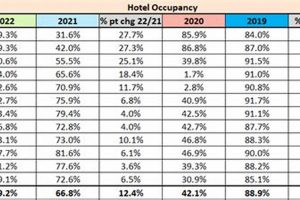Extended-stay accommodations are offered by a variety of lodging establishments, providing guests with reduced pricing for longer-term bookings, typically spanning a month or more. These options range from budget-friendly motels to upscale hotel chains and furnished apartments. An example might be a business traveler needing temporary housing during a project or a family relocating and seeking temporary residence.
The availability of such arrangements provides significant advantages for both travelers and lodging providers. Guests benefit from cost savings compared to daily rates, along with the convenience and stability of a more permanent living situation. Hotels, in turn, secure guaranteed occupancy for extended periods, contributing to a more predictable revenue stream. This practice has evolved alongside changing travel patterns, reflecting a growing demand for flexible, cost-effective lodging options for both business and leisure purposes.
This article will delve deeper into the specifics of finding and securing these longer-term accommodation options. Topics covered will include a comparison of different types of extended-stay accommodations, strategies for negotiating favorable rates, and essential factors to consider when choosing a monthly stay.
Tips for Securing Extended-Stay Accommodations
Locating suitable and cost-effective extended-stay accommodations requires careful planning and research. The following tips offer guidance for navigating this process effectively.
Tip 1: Book Directly with the Hotel: Direct booking often yields better rates than using third-party booking sites. Contacting the hotel’s sales department can be particularly beneficial for negotiating monthly rates.
Tip 2: Consider Location and Amenities: Evaluate proximity to essential services like grocery stores, pharmacies, and transportation options. Determine which amenities are essential for a comfortable stay, such as kitchen facilities, laundry, and internet access.
Tip 3: Compare Different Types of Accommodations: Explore various options, including extended-stay hotels, apartment hotels, and furnished apartments, to identify the best fit based on budget and needs.
Tip 4: Inquire About Discounts: Corporate, AAA, or senior discounts can sometimes be applied to extended stays, potentially lowering the overall cost.
Tip 5: Read Reviews Carefully: Online reviews provide valuable insights into the experiences of previous long-term guests, highlighting potential advantages and disadvantages of specific properties.
Tip 6: Understand the Terms and Conditions: Carefully review the cancellation policy, payment terms, and any included or excluded services in the monthly rate (e.g., housekeeping, utilities).
Tip 7: Negotiate: Don’t hesitate to negotiate rates, particularly during off-season or for longer stays. Flexibility with dates can also lead to better deals.
By employing these strategies, travelers can optimize their search for extended-stay accommodations and secure comfortable lodging at a favorable price. Careful preparation allows for more informed decisions and ultimately contributes to a more satisfying experience.
In conclusion, finding suitable extended-stay accommodations requires a proactive and informed approach. By following these guidelines, individuals can secure cost-effective, comfortable lodging tailored to their specific requirements.
1. Hotel Type
Hotel type significantly influences the availability and structure of monthly rates. Different categories of hotels cater to varying guest demographics and lengths of stay, impacting their pricing models and offered services. Understanding these distinctions is crucial for locating suitable extended-stay accommodations.
- Budget Hotels/Motels:
Budget-friendly establishments may offer weekly or monthly rates, primarily targeting travelers seeking basic accommodations for extended periods. These rates are typically lower but may not include amenities beyond basic necessities. Examples include Motel 6 and Super 8. While cost-effective, these options may lack the comfort and services of higher-tier accommodations.
- Extended-Stay Hotels:
These hotels specifically cater to long-term guests, offering amenities such as kitchenettes, laundry facilities, and workspaces. Residence Inn and Homewood Suites are prime examples. Monthly rates are standard practice, often providing significant discounts compared to daily or weekly rates. The focus is on providing a comfortable and convenient environment for extended stays.
- Apartment Hotels:
Properties like Oakwood and Staybridge Suites blend hotel services with apartment-style living. They offer fully equipped kitchens, separate living areas, and often provide housekeeping services. Monthly rates are common and competitive, making them attractive for relocating individuals or families.
- Luxury Hotels:
While less common, some upscale hotels may offer monthly rates, particularly for guests seeking extended stays with premium services and amenities. The Four Seasons and Ritz-Carlton are examples of luxury chains that may accommodate such requests. These rates, while higher, provide access to luxurious accommodations and services.
The hotel type chosen directly correlates with the overall cost, amenities, and services available for extended stays. Careful consideration of these factors allows travelers to select accommodations aligned with their budget and desired level of comfort and convenience. Understanding these variations is essential when researching extended-stay options.
2. Location
Location plays a critical role in determining both the availability and pricing of extended-stay accommodations. Several factors influence this relationship, including proximity to business districts, local demand, and overall cost of living in the area. Metropolitan areas with high business activity often have greater demand for extended-stay options, but competition can also lead to a wider range of pricing. Conversely, hotels in smaller towns or rural areas may offer lower monthly rates due to decreased demand, though the selection might be more limited. Coastal destinations or resort areas may exhibit seasonal fluctuations, with higher rates during peak tourist seasons and more competitive monthly rates during the off-season. For example, a business traveler seeking extended stay in New York City will likely encounter higher rates than someone looking for similar accommodations in a smaller Midwestern city.
The surrounding infrastructure and accessibility of amenities also significantly influence the desirability and pricing of extended-stay hotels. Proximity to public transportation, grocery stores, restaurants, and entertainment venues can impact the overall cost. Hotels located in prime locations with convenient access to these amenities often command higher rates. For instance, a hotel situated near a major transportation hub or within walking distance of restaurants might justify a higher monthly rate due to its convenient location. Conversely, hotels further from these conveniences might offer more competitive pricing to offset the inconvenience. This dynamic creates a trade-off between cost and accessibility, requiring careful consideration based on individual needs and priorities.
Understanding the interplay between location and extended-stay pricing is crucial for informed decision-making. Researching local market conditions, considering proximity to necessary amenities, and evaluating the overall cost of living in the area allows for a comprehensive assessment. This approach enables travelers to identify accommodations that offer the optimal balance between cost, convenience, and accessibility. Analyzing these factors within the context of individual needs and travel purposes empowers individuals to make informed choices and secure appropriate lodging for extended stays.
3. Duration of Stay
Duration of stay acts as a pivotal factor influencing the availability and structure of extended-stay rates. Hotels typically offer a tiered pricing structure, with nightly rates decreasing incrementally as the length of stay increases. This pricing strategy incentivizes longer bookings, providing guests with cost savings and hotels with guaranteed occupancy. The relationship between duration and rate varies depending on factors such as hotel type, location, and seasonality. For instance, a budget hotel might offer a weekly discount, while an extended-stay hotel might provide significantly reduced monthly rates. A resort hotel might only offer extended-stay discounts during the off-season. Understanding these variations empowers informed decision-making, allowing travelers to optimize their lodging expenses based on their intended duration of stay.
The cause-and-effect relationship between duration and pricing is driven by several economic considerations. For hotels, longer stays translate to reduced administrative overhead associated with frequent check-ins and check-outs, as well as lower marketing costs for securing occupancy. These savings are then passed on to guests in the form of reduced rates. For travelers, extended-stay rates offer substantial cost savings compared to accumulating daily or weekly rates, particularly for durations exceeding a month. This cost advantage is especially pertinent for individuals relocating, undergoing temporary work assignments, or requiring temporary housing for other reasons. A concrete example would be a consultant on a three-month project benefiting significantly from a monthly rate at an extended-stay hotel compared to paying the standard nightly rate. This allows budget allocation for other expenses, making extended stays more financially manageable.
In summary, duration of stay stands as a critical component in determining the cost-effectiveness of extended accommodations. The tiered pricing structure employed by hotels rewards longer stays with lower rates, offering mutual benefits to both the lodging provider and the guest. Understanding this dynamic allows travelers to strategically plan their stays and optimize their lodging budget. This knowledge is particularly crucial for those requiring temporary housing for an extended period, allowing for more efficient resource allocation and informed financial decisions.
4. Amenities Offered
The range and quality of amenities offered significantly influence which hotels provide monthly rates and the pricing structure of those rates. This correlation stems from the understanding that extended-stay guests require more than just a room; they need a comfortable and functional living space. Hotels catering to this demographic often incorporate amenities designed for longer-term stays, which in turn affects their pricing models. Essential amenities such as kitchenettes, in-suite laundry facilities, and dedicated workspaces cater to the practical needs of extended-stay guests. These additions often justify a higher monthly rate compared to hotels offering only basic amenities. For instance, an extended-stay hotel with a fully equipped kitchen might command a higher monthly rate than a budget hotel offering only a microwave and mini-fridge. Conversely, the inclusion of amenities can also increase the overall value proposition, making a slightly higher monthly rate more appealing than a lower rate at a hotel lacking essential conveniences.
The cause-and-effect relationship between amenities and extended-stay pricing stems from several factors. Hotels investing in amenities incur higher operational costs, including maintenance, upkeep, and staffing. These costs are factored into the monthly rates, influencing the overall pricing structure. Additionally, the demand for specific amenities can impact pricing. High-demand features like fitness centers, swimming pools, or business centers can contribute to higher rates, reflecting the added value they provide to guests. For example, a hotel with a well-equipped fitness center might charge a premium compared to a hotel without such facilities. Conversely, hotels lacking desirable amenities might offer lower monthly rates to remain competitive. This interplay of supply, demand, and operational costs shapes the relationship between amenities and pricing within the extended-stay market. Understanding these factors allows potential guests to assess the value proposition offered by different hotels and select accommodations aligned with their needs and budget.
In conclusion, the availability and pricing of monthly rates are inextricably linked to the amenities provided. Hotels catering to extended-stay guests often incorporate features designed for longer-term living, impacting their pricing structures. The value proposition offered by these amenities plays a crucial role in guest decision-making, influencing their choice of accommodation. Evaluating the cost-benefit ratio of amenities offered versus the monthly rate allows travelers to make informed decisions and secure lodging that meets both their practical needs and budgetary constraints. This understanding is crucial for navigating the extended-stay market effectively and securing appropriate, comfortable, and cost-effective accommodations.
5. Rate Variations
Rate variations represent a crucial component within the landscape of extended-stay accommodations. Multiple factors influence the fluctuation of monthly rates, impacting both availability and affordability. Understanding these dynamics is essential for securing optimal lodging arrangements. Seasonality significantly influences pricing, with peak seasons often commanding higher rates due to increased demand. Conversely, during the off-season, hotels may offer lower monthly rates to attract guests. Location also plays a critical role, with urban centers and popular tourist destinations typically exhibiting higher rates compared to less densely populated areas. Hotel type further contributes to rate variations, as budget-friendly establishments typically offer lower monthly rates than upscale hotels, reflecting differences in amenities and services. Competition within a specific market can also drive rate adjustments, as hotels strive to remain competitive while maintaining profitability. For example, a beachfront hotel in Florida might offer lower monthly rates during the summer hurricane season, while a ski resort in Colorado might have higher rates during the peak ski season. Similarly, a budget hotel chain in a competitive market might offer lower monthly rates than a luxury hotel in the same area.
The cause-and-effect relationship between these factors and rate variations stems from fundamental economic principles. Supply and demand dynamics directly influence pricing, with high demand during peak seasons or in popular locations leading to increased rates. Operational costs, including staffing, utilities, and maintenance, also contribute to rate variations, as hotels adjust pricing to maintain profitability. Market competition further exerts pressure on pricing strategies, compelling hotels to offer competitive rates to attract guests while balancing revenue goals. Understanding these interconnected factors allows potential guests to anticipate and navigate rate fluctuations effectively. For instance, travelers with flexible schedules can leverage off-season discounts to secure lower monthly rates. Similarly, comparing rates across different hotel types within a given location enables informed decision-making based on individual budgetary constraints and desired amenities. Real-life examples include business travelers negotiating lower monthly rates during the off-season for extended projects or families securing discounted rates at apartment hotels during the summer months.
In summary, rate variations represent a dynamic aspect of extended-stay accommodations, influenced by a confluence of factors including seasonality, location, hotel type, and market competition. Understanding these influences empowers travelers to make informed decisions regarding timing, location, and accommodation choices. This knowledge facilitates strategic planning and budget optimization, ultimately enabling individuals to secure cost-effective and suitable lodging for extended stays. Navigating these variations successfully requires careful research, flexibility, and a clear understanding of individual needs and priorities.
6. Target Demographics
Target demographics significantly influence which hotels offer monthly rates and how those rates are structured. The specific needs and preferences of different demographic groups shape the types of accommodations offered and the associated pricing strategies. This connection stems from the understanding that extended-stay guests represent diverse segments of the population, each with unique requirements. For instance, business travelers prioritize convenient locations, reliable internet access, and often require on-site business facilities. Relocating families, on the other hand, may prioritize larger suites with kitchen facilities, laundry amenities, and proximity to schools and childcare services. Hotels catering to these distinct demographics tailor their offerings and pricing accordingly. This targeted approach allows hotels to optimize occupancy rates and revenue streams by aligning their services with the specific demands of their target market. The cause-and-effect relationship is evident: identifying a specific target demographic informs the hotel’s service offerings, which in turn dictates the pricing structure for extended stays. For example, hotels targeting business travelers might offer higher monthly rates that include access to executive lounges and meeting rooms, while those catering to families might offer slightly lower rates with family-oriented amenities like play areas or kids’ clubs.
The importance of target demographics as a component of understanding extended-stay offerings cannot be overstated. Accurate identification of the target market allows hotels to tailor amenities, services, and marketing strategies effectively. This focused approach results in higher occupancy rates, increased customer satisfaction, and improved profitability. Failing to consider target demographics can lead to misaligned services, ineffective marketing, and ultimately, lower revenue. Real-life examples illustrate this connection: a hotel chain focusing on budget-conscious travelers might offer basic extended-stay accommodations with limited amenities at competitive monthly rates. Conversely, a luxury hotel chain targeting affluent travelers might offer premium suites with a comprehensive range of services at significantly higher monthly rates. This targeted approach ensures that each hotel caters effectively to the specific needs and expectations of its intended customer base. Understanding this dynamic allows travelers to identify hotels that align with their individual needs and budget, resulting in a more satisfactory extended-stay experience.
In conclusion, target demographics play a pivotal role in shaping the availability and structure of monthly rates in the hospitality industry. The specific needs and preferences of different demographic groups directly influence the types of accommodations offered, the included amenities, and the associated pricing strategies. Recognizing this connection empowers both hotels and travelers. Hotels can optimize their offerings to attract and retain their target market, while travelers can efficiently locate accommodations tailored to their individual requirements and budget. A thorough understanding of this dynamic is essential for navigating the extended-stay market effectively and ensuring a mutually beneficial outcome for both lodging providers and guests.
Frequently Asked Questions about Extended Stay Hotel Rates
This section addresses common inquiries regarding extended-stay accommodations and associated monthly rates. Clear and concise answers aim to provide a comprehensive understanding of this aspect of the hospitality industry.
Question 1: What constitutes an extended stay in a hotel?
Extended stays typically refer to bookings of 30 days or more. However, some hotels may consider stays of a week or longer as extended stays, offering discounted rates accordingly. Specific definitions vary among establishments.
Question 2: How do monthly rates compare to daily or weekly rates?
Monthly rates typically offer significant cost savings compared to accumulating daily or weekly rates. The extent of the discount varies based on factors such as location, hotel type, and seasonality.
Question 3: Are utilities included in monthly hotel rates?
Inclusion of utilities in monthly rates depends on the hotel’s policy. Some hotels include utilities in the quoted rate, while others bill separately. Clarification with the hotel directly is recommended.
Question 4: What amenities are typically included in extended-stay accommodations?
Extended-stay hotels often provide amenities such as kitchenettes, in-suite laundry facilities, and dedicated workspaces. However, the specific amenities offered vary among establishments and may influence the overall rate.
Question 5: How can one find hotels offering monthly rates?
Online travel agencies, hotel websites, and direct contact with hotel sales departments are effective methods for locating extended-stay options and inquiring about monthly rates.
Question 6: Are monthly rates negotiable?
Negotiating monthly rates is often possible, particularly during off-season periods or for longer stays. Direct communication with the hotel’s sales or reservations department is recommended for exploring negotiation possibilities.
Understanding these frequently asked questions provides a solid foundation for navigating the extended-stay market. Careful consideration of these factors enables informed decision-making and facilitates securing appropriate and cost-effective accommodations.
Further exploration of specific hotel policies and offerings is recommended for a comprehensive understanding tailored to individual needs.
Conclusion
This exploration of extended-stay accommodations and monthly rates has highlighted key factors influencing their availability, pricing, and suitability for various demographics. Hotel type, location, duration of stay, amenities offered, rate variations, and target demographics each play a significant role in shaping the extended-stay market. Understanding these interconnected elements is crucial for informed decision-making. Careful consideration of these factors empowers travelers to identify accommodations aligning with individual needs, budgetary constraints, and desired amenities. Effective research, strategic planning, and direct communication with hotels facilitate securing optimal lodging arrangements for extended stays.
The evolving landscape of extended-stay accommodations reflects changing travel patterns and the increasing demand for flexible, cost-effective lodging solutions. As the hospitality industry adapts to these evolving needs, the market for extended-stay accommodations is likely to expand further, offering a wider range of options for travelers. Continued research and awareness of market trends will remain essential for navigating this evolving landscape and securing advantageous extended-stay arrangements in the future.







